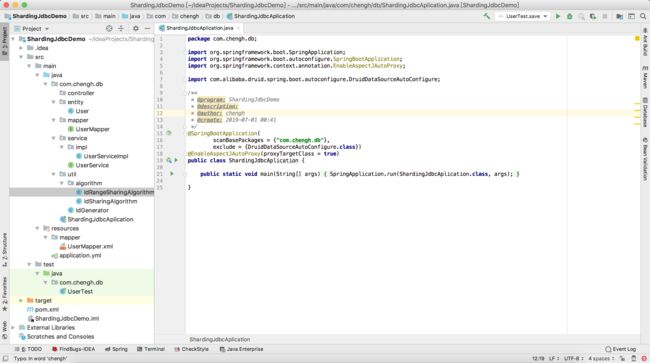sharding-jdbc系列(二):在spring boot下的分库分表运用
本文使用的是spring boot+mybatis+sharding-jdbc+druid。
项目整体结构
单库分表集成
项目背景:
创建一个数据库user0,假设只有一张表t_user需要进行分表,分为2张表t_user0、t_user1,分片字段为主键id,采用取余的分片算法(%2)。
创建对应的数据库及表
create database user0;
CREATE TABLE `t_user0` (
`id` bigint(20) NOT NULL,
`name` varchar(30) DEFAULT NULL COMMENT '名称',
`sex` tinyint(2) DEFAULT NULL COMMENT '性别 0-男,1-女',
`phone` varchar(15) DEFAULT NULL COMMENT '电话',
`email` varchar(30) DEFAULT NULL COMMENT '邮箱',
`password` varchar(20) DEFAULT NULL COMMENT '密码',
`create_time` timestamp NULL DEFAULT CURRENT_TIMESTAMP ON UPDATE CURRENT_TIMESTAMP COMMENT '创建时间',
PRIMARY KEY (`id`)
) ENGINE=InnoDB DEFAULT CHARSET=utf8;
CREATE TABLE `t_user1` (
`id` bigint(20) NOT NULL,
`name` varchar(30) DEFAULT NULL COMMENT '名称',
`sex` tinyint(2) DEFAULT NULL COMMENT '性别 0-男,1-女',
`phone` varchar(15) DEFAULT NULL COMMENT '电话',
`email` varchar(30) DEFAULT NULL COMMENT '邮箱',
`password` varchar(20) DEFAULT NULL COMMENT '密码',
`create_time` timestamp NULL DEFAULT CURRENT_TIMESTAMP ON UPDATE CURRENT_TIMESTAMP COMMENT '创建时间',
PRIMARY KEY (`id`)
) ENGINE=InnoDB DEFAULT CHARSET=utf8;创建一个spring boot项目,使用sharding-jdbc-spring-boot-starter集成,本文使用版本为3.0.0。pom.xml配置:
4.0.0
org.springframework.boot
spring-boot-starter-parent
2.1.4.RELEASE
com.chengh
dbTest
1.0.0-SNAPSHOT
1.3.0
1.1.10
4.12
3.0.0
org.springframework.boot
spring-boot-starter-web
org.mybatis.spring.boot
mybatis-spring-boot-starter
${mybatis.version}
mysql
mysql-connector-java
runtime
org.springframework.boot
spring-boot-starter-test
test
com.alibaba
druid-spring-boot-starter
${druid.version}
junit
junit
${junit.version}
io.shardingsphere
sharding-jdbc-spring-boot-starter
${sharding.jdbc.version}
org.springframework
spring-aop
4.3.12.RELEASE
org.springframework
spring-aspects
4.3.12.RELEASE
com.alibaba
fastjson
1.2.58
src/main/java
**/*.xml
true
src/main/resources
**/*.xml
**/*.yml
true
添加对应的实体类
public class User {
private Long id;
private String name;
private String phone;
private String email;
private String password;
private Integer sex;
private Date createTime;
}创建Mapper
@Mapper
public interface UserMapper {
/**
* 保存
*/
void save(User user);
/**
* 查询
* @param ids
* @return
*/
List getByIds(@Param("ids") List ids);
} UserMapper.xml
INSERT INTO t_user(id,name,phone,email,sex,password,create_time)
VALUES
(
#{id},#{name},#{phone},#{email},#{sex},#{password},#{createTime}
)
application.yml
application.yml进行分片规则及数据源等的一些配置,采用行表达式的形式配置。
server:
port: 8080
mybatis:
mapper-locations: classpath*:mapper/*Mapper.xml
sharding:
jdbc:
datasource:
names: ds0
# 数据源ds0
ds0:
type: com.alibaba.druid.pool.DruidDataSource
driver-class-name: com.mysql.jdbc.Driver
url: jdbc:mysql://localhost:3306/chengh?useUnicode=true&characterEncoding=utf8
username: root
password: 123
config:
sharding:
props:
sql.show: true
tables:
t_user: #t_user表
key-generator-column-name: id #主键
actual-data-nodes: ds0.t_user${0..1} #数据节点,均匀分布
table-strategy: #分表策略
inline: #行表达式
sharding-column: id
algorithm-expression: t_user${id % 2} #按模运算分配启动类
/**
* @program: ShardingJdbcDemo
* @description:
* @author: chengh
* @create: 2019-07-01 00:41
*/
@SpringBootApplication(
scanBasePackages = {"com.chengh.db"},
exclude = {DruidDataSourceAutoConfigure.class})
@EnableAspectJAutoProxy(proxyTargetClass = true)
public class ShardingJdbcAplication {
public static void main(String[] args) {
SpringApplication.run(ShardingJdbcAplication.class, args);
}
}至此,一个简单的spring boot下的sharding-jdbc分表项目初步完成,下面来编写测试用例,spring boot下我们可以方便的使用注解@SpringBootTest来进行单元测试。
@RunWith(SpringJUnit4ClassRunner.class)
@SpringBootTest(webEnvironment = SpringBootTest.WebEnvironment.MOCK, classes = ShardingJdbcAplication.class)
@WebAppConfiguration
public class UserTest {
@Autowired
UserMapper userMapper;
@Resource
IdGenerator idGenerator;
@Test
public void save() {
for (Integer i = 0; i < 100; i++) {
User user = new User();
user.setId(i.longValue());
user.setName("chengh" + i);
user.setCreateTime(new Date());
user.setSex(i % 2);
user.setPhone("12345678910");
user.setEmail("[email protected]");
user.setPassword("123456");
userMapper.save(user);
}
}
@Test
public void getByIds() {
System.out.println(JSON.toJSONString(
userMapper.getById(12L)));
}
}上面采用的是行表达式形式配置的分片策略,我们还可以自己定义自己的分片规则,默认提供了5种分片策略,我们尝试自己编写一个标准的分片策略:
- 标准分片策略:对应StandardShardingStrategy。提供对SQL语句中的=, IN和BETWEEN AND的分片操作支持。StandardShardingStrategy只支持单分片键,提供PreciseShardingAlgorithm和RangeShardingAlgorithm两个分片算法。PreciseShardingAlgorithm是必选的,用于处理=和IN的分片。RangeShardingAlgorithm是可选的,用于处理BETWEEN AND分片,如果不配置RangeShardingAlgorithm,SQL中的BETWEEN AND将按照全库路由处理。
/**
* @program: ShardingJdbcDemo
* @description:
* @author: chengh
* @create: 2019-07-01 00:41
*/
public class IdSharingAlgorithm implements PreciseShardingAlgorithm {
@Override
public String doSharding(Collection collection, PreciseShardingValue preciseShardingValue) {
System.out.println("collection: " + JSON.toJSONString(collection) + " ,preciseShardingValue: "
+ JSON.toJSONString(preciseShardingValue));
Long id = preciseShardingValue.getValue();
for (String name : collection) {
if (name.endsWith(id % collection.size() + "")) {
System.out.println("return name: " + name);
return name;
}
}
throw new IllegalArgumentException();
}
} /**
* @program: ShardingJdbcDemo
* @description:
* @author: chengh
* @create: 2019-07-01 00:41
*/
public class IdRangeSharingAlgorithm implements RangeShardingAlgorithm {
@Override
public Collection doSharding(Collection collection, RangeShardingValue rangeShardingValue) {
System.out.println("collection: " + JSON.toJSONString(collection) + " ,rangeShardingValue: "
+ JSON.toJSONString(rangeShardingValue));
Collection collect = new ArrayList<>();
Range valueRange = rangeShardingValue.getValueRange();
for (Long i = valueRange.lowerEndpoint(); i <= valueRange.upperEndpoint(); i++) {
for (String each : collection) {
if (each.endsWith(i % collection.size() + "")) {
collect.add(each);
}
}
}
return collect;
}
} 修改application.yml
server:
port: 8080
mybatis:
mapper-locations: classpath*:mapper/*Mapper.xml
sharding:
jdbc:
datasource:
names: ds0
# 数据源ds0
ds0:
type: com.alibaba.druid.pool.DruidDataSource
driver-class-name: com.mysql.jdbc.Driver
url: jdbc:mysql://localhost:3306/chengh?useUnicode=true&characterEncoding=utf8
username: root
password: 123
config:
sharding:
props:
sql.show: true
tables:
t_user: #t_user表
key-generator-column-name: id #主键
actual-data-nodes: ds0.t_user${0..2} #数据节点,均匀分布
table-strategy: #分表策略
standard:
sharding-column: id
precise-algorithm-class-name: com.chengh.db.util.algorithm.IdSharingAlgorithm
range-algorithm-class-name: com.chengh.db.util.algorithm.IdRangeSharingAlgorithm分库也分表
再创建一个数据库user1,同样创建两张表t_user0、t_user1。再只需要修改一下分片规则就可以了。
server:
port: 8080
mybatis:
mapper-locations: classpath*:mapper/*Mapper.xml
sharding:
jdbc:
datasource:
names: dso,ds1
# 数据源ds0
dso:
type: com.alibaba.druid.pool.DruidDataSource
driver-class-name: com.mysql.jdbc.Driver
url: jdbc:mysql://localhost:3306/user0?useUnicode=true&characterEncoding=utf8
username: root
password: 123
# 数据源ds1
ds1:
type: com.alibaba.druid.pool.DruidDataSource
driver-class-name: com.mysql.jdbc.Driver
url: jdbc:mysql://localhost:3306/user1?useUnicode=true&characterEncoding=utf8
username: root
password: 123
config:
sharding:
props:
sql.show: true
tables:
t_user: #t_user表
key-generator-column-name: id #主键
actual-data-nodes: ds${0..1}.t_user${0..1} #数据节点,均匀分布
database-strategy: #分表策略
inline: #行表达式
sharding-column: id #列名称,多个列以逗号分隔
algorithm-expression: ds${id % 2} #按模运算分配
table-strategy: #分表策略
standard:
sharding-column: id
precise-algorithm-class-name: com.chengh.db.util.algorithm.IdSharingAlgorithm
range-algorithm-class-name: com.chengh.db.util.algorithm.IdRangeSharingAlgorithm最后附上一张运行效果图:
运行单元测试的save方法,可以看到控制台打印出的部分信息如下:
2019-07-04 18:04:27.131 INFO 17068 --- [ main] Sharding-Sphere-SQL : Rule Type: sharding
2019-07-04 18:04:27.133 INFO 17068 --- [ main] Sharding-Sphere-SQL : Logic SQL: INSERT INTO t_user(id,name,phone,email,sex,password)
VALUES
(
?,?,?,?,?,?
)
2019-07-04 18:04:27.133 INFO 17068 --- [ main] Sharding-Sphere-SQL : SQLStatement: InsertStatement(super=DMLStatement(super=AbstractSQLStatement(type=DML, tables=Tables(tables=[Table(name=t_user, alias=Optional.absent())]), conditions=Conditions(orCondition=OrCondition(andConditions=[AndCondition(conditions=[Condition(column=Column(name=id, tableName=t_user), operator=EQUAL, positionValueMap={}, positionIndexMap={0=0})])])), sqlTokens=[TableToken(skippedSchemaNameLength=0, originalLiterals=t_user), io.shardingsphere.core.parsing.parser.token.InsertValuesToken@3878be7b], parametersIndex=6)), columns=[Column(name=id, tableName=t_user), Column(name=name, tableName=t_user), Column(name=phone, tableName=t_user), Column(name=email, tableName=t_user), Column(name=sex, tableName=t_user), Column(name=password, tableName=t_user)], generatedKeyConditions=[GeneratedKeyCondition(column=Column(name=id, tableName=t_user), index=0, value=null)], insertValues=InsertValues(insertValues=[InsertValue(type=VALUES, expression=(
?,?,?,?,?,?
), parametersCount=6)]), columnsListLastPosition=51, generateKeyColumnIndex=0, insertValuesListLastPosition=111)
2019-07-04 18:04:27.134 INFO 17068 --- [ main] Sharding-Sphere-SQL : Actual SQL: ds0 ::: INSERT INTO t_user0(id,name,phone,email,sex,password)
VALUES
(
?,?,?,?,?,?
) ::: [[0, chengh0, 12345678910, [email protected], 0, 123456]]
2019-07-04 18:04:27.206 INFO 17068 --- [ main] Sharding-Sphere-SQL : Rule Type: sharding
2019-07-04 18:04:27.206 INFO 17068 --- [ main] Sharding-Sphere-SQL : Logic SQL: INSERT INTO t_user(id,name,phone,email,sex,password)
VALUES
(
?,?,?,?,?,?
)
2019-07-04 18:04:27.206 INFO 17068 --- [ main] Sharding-Sphere-SQL : SQLStatement: InsertStatement(super=DMLStatement(super=AbstractSQLStatement(type=DML, tables=Tables(tables=[Table(name=t_user, alias=Optional.absent())]), conditions=Conditions(orCondition=OrCondition(andConditions=[AndCondition(conditions=[Condition(column=Column(name=id, tableName=t_user), operator=EQUAL, positionValueMap={}, positionIndexMap={0=0})])])), sqlTokens=[TableToken(skippedSchemaNameLength=0, originalLiterals=t_user), io.shardingsphere.core.parsing.parser.token.InsertValuesToken@3878be7b], parametersIndex=6)), columns=[Column(name=id, tableName=t_user), Column(name=name, tableName=t_user), Column(name=phone, tableName=t_user), Column(name=email, tableName=t_user), Column(name=sex, tableName=t_user), Column(name=password, tableName=t_user)], generatedKeyConditions=[GeneratedKeyCondition(column=Column(name=id, tableName=t_user), index=0, value=null)], insertValues=InsertValues(insertValues=[InsertValue(type=VALUES, expression=(
?,?,?,?,?,?
), parametersCount=6)]), columnsListLastPosition=51, generateKeyColumnIndex=0, insertValuesListLastPosition=111)
2019-07-04 18:04:27.206 INFO 17068 --- [ main] Sharding-Sphere-SQL : Actual SQL: ds1 ::: INSERT INTO t_user1(id,name,phone,email,sex,password)
VALUES
(
?,?,?,?,?,?
) ::: [[1, chengh1, 12345678910, [email protected], 1, 123456]]
根据打印出来的信息,可以看到我们书写的Logic SQL及经过解析改写后选择的数据库和实际执行的Actual SQL。
附项目git地址:https://github.com/chengh1/ShardingJdbcDemo
